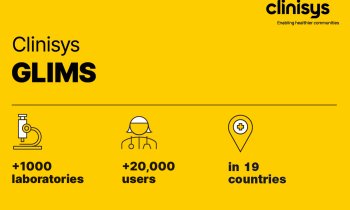Romania
by Manole Cojocaru MD PhD
In preparation for EU entry, Romania's laboratories are in the process of raising standards.

Last year ROMAR Medical-Colentina Clinical Laboratory, ROMAR Medical, based in Bucharest, received accreditation from the Romanian Accreditation Association (RENAR).
This example shows the increasing awareness in medical laboratories of the need for total quality management. A quality system requires a quality manual to be compiled, describing the laboratory’s organisation, including functionality and staff organisation. Operating procedures should describe pre-analytical, analytical and post-analytical activities.
In daily clinical practice, physicians request laboratory tests to assist in diagnosis, monitor a patient and to suggest or change a treatment. Activities need to be standardised to harmonise test results, and new parameters set to aid prevention, diagnosis and therapy monitoring of various diseases. In the implementation of knowledge-based systems to improve medical knowledge it is evident that such developments are also connected with several analytical and interpretative problems for the laboratory scientific consultant as well as the clinician.
Laboratory results might be outside the normal range. All analytes are entered using various units that are converted internally to those in the knowledge base. Both the original and converted units are listed in the report. Variations may be caused, for example, by race, dietetic preference, age, sex, menstrual cycle, degree of physical activity, problems with collection and/or handing of the specimen, non-prescription/prescription drugs, alcohol intake and a number of non-illness-related factors. Any unusual or abnormal results are discussed with the physician. It is not possible to diagnose or treat any disease or problem with a blood test alone. An abnormal test does not mean that something is wrong. Discussion of results between laboratory staff and clinicians plays a crucial role in the use of knowledge-based systems in laboratory medicine.
The basis of interpretation of the analytes is not limited to a comparison with the reference ranges. The final report consists of laboratory findings, with partly age and sex-dependent reference ranges in a table, and the knowledge-based interpretation resulting from selected text items. The interpretative text covers not only underlying disorders but also comments on pre-analytical and analytical problems - measures needed to improve comparability of test results in the disease state.
A laboratory result is only as good as the understanding of its meaning and the action taken upon its receipt. As more and more diagnostic tests become available, the laboratory’s role is becoming a provider of knowledge (and interpretation) rather than results. Thus we must find ways to enhance the role of laboratory medicine professionals as clinical consultants by basing our clinical research on evidence-based medicine and working with our medical care partners to translate emerging laboratory sciences into services that enhance the quality of care. We must also continue to develop high-quality scientific programmes for students and recent graduates.
No diagnostic test is 100% effective. A test has a potential for false negative results (abnormality may be present but not detected) and false positive results (an abnormality is reported but does not actually exist). In Colentina Central Clinical Laboratory over 50% of reports contain significant abnormalities. It is totally impracticable for our lab to contact requesting clinicians directly about every report that contains unexpected abnormalities or that may be liable to misinterpretation.
Unreliable laboratory results may have serious consequences for the health of an individual - and the community. The initial concept of quality control (QC) was concentrated organisation of the evaluation of analytical performance, i.e. the testing of analytical sensitivity and specificity, as well as of accuracy and reproducibility. Later, that concept was expended to quality assurance (QA), which incorporates broader organisational issues, including patient preparation, specimen collection, specimen processing, measurement performance, validation of results as well as their reporting and interpretation. It is also essential to interpret results in the light of the patient’s history and in the clinical context. The main objective of QA is to provide reliable laboratory data and to ensure inter-laboratory comparability of results, to improve the accuracy of clinical diagnoses, and to reduce costs (via avoidance of repeat tests). Total quality management (TQM) means that every variable that could possibly affect the quality of the test results has been controlled. TQM of laboratory services requires a comprehensive system of quality surveillance that integrates quality development, maintenance and improvement. Accuracy was defined quite simply as the relationship between the actual, observed result and the true result of an analysis. Precision is the reproducibility of a given degree of accuracy. Both require QC to maintain them within acceptable limits in the laboratory. Techniques of QC needed to be used in all branches of pathology. To be successful, QC must be independently applied to commercial materials and the work of laboratories themselves. An effective QA programme covers all aspects of the clinical laboratory. QC begins at the time of specimen collection from a patient, not afterwards. In the lab, the aim of QA is good workflow via all phases (pre-analytical, analytical and post-analytical). From then until a result is achieved we need to control random errors, day-to-day errors in reading or performance, largely unavoidable and systematic errors and those with a definite cause.
For Colentina Central Clinical Laboratory, internal quality control is both preventive and prospective. An important element in maintaining day-to-day uniformity in lab results is an established procedure manual, used by all laboratory personnel, which details all phases of the lab’s operation (including safety precautions). It should include instructions for collecting, transporting, and storing specimens, preparing and storing reagents, and for performing tests. In addition, controls and calibrators should be listed along with directions for their use, expected results, and instructions for corrective measures if the expected results are not obtained.
Guidelines for the collection and transportation of specimens should be available to clinicians in a lucidly written format. These should be regularly revised depending upon the needs and the availability of new technology. There should be frequent (at least annual) consultations between physicians, nurses and the laboratory, to update guidelines. Quality is the degree of congruence between expectation and realisation. The basic aim of QA is to generate the confidence of the user in the final report.
The Central Clinical Laboratory in Colentina has a well-defined and constant workload. Each speciality and department function independently. The team faced assessment of a series of challenges and opportunities. For example, could the volume of samples needed be reduced, potentially reducing lab administration as well as patient trauma? What might be the role and impact of sample handling robotics and the reduction of sample splitting? Before committing to such major change, detailed analysis of process, workflow and technical analysis in each area has been necessary. Key decisions for the team included whether or not to move to using a single sample tube for clinical chemistry and immunoassay.
The laboratory operates 24/7 and all performance targets have been achieved. The centralised laboratory improves service to our clinicians and creates a more stimulating environment for everyone in the department.
As we have seen, careful process analysis can lead to the development of radical solutions. Using flexible automation and integration, significant process improvements and workflow enhancements can be organised.
Organisation and consolidation is now a reality. Such effects must be followed carefully if a lab is to remain a reference laboratory in our country. An additional consideration is the role of the emergency laboratory and what opportunities exist to integrate this part of the service into the central laboratory. The trend for laboratory organisation has led to the need to effectively process a large numbers of tests - rapidly and effectively. We can introduce emergency samples at any time, without interrupting routine workflow. The central laboratory is compatible with the hospital’s emergency needs and provides a turnaround of 30-40 minutes for all samples. Every report is signed. The physician has to control plausibility and correct errors, namely before sending. Clinically relevant results are immediately discussed with the physician by phone.
Progress in medical science typically follows a stepwise course: a phenomenon is noted and described; a method for its measurements is devised; through the application of the method, new correlations are established between the phenomenon and its clinical manifestations. This conclusion is consistent with my own views from my vantage point as the scientific consultant
07.08.2006










